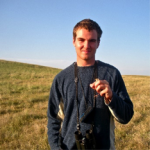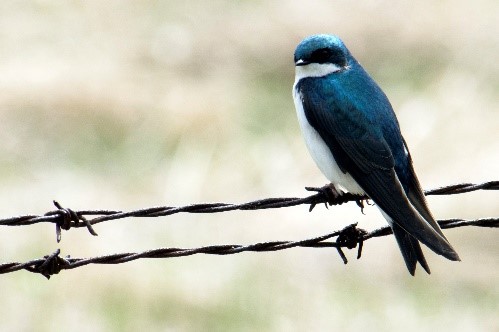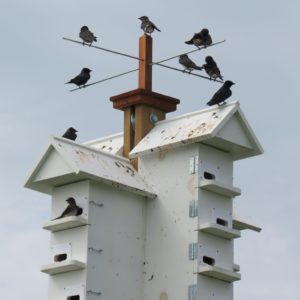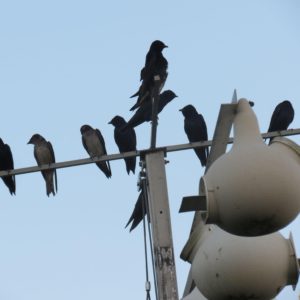Imperiled Insectivores: What We Know and How We Can Learn More

Sean Feagan, Guest Blogger
This post was written by guest blogger Sean Feagan.
An aerial insectivore is a behavioural term used to describe species that feed almost exclusively on insects while on the wing. In regards to birds, they are comprised of species belonging to four bird families: swifts, swallows, flycatchers and nightjars. In addition to being beautiful, these birds help control insect populations. Despite being protected under the federal Migratory Birds Convention Act, aerial insectivore bird populations are declining rapidly. This is a serious problem. For example, Tree Swallow (note the striking iridescence) as pictured below, has declined by an estimated 2.25 percent per year from 1966 to 2015.
Figure 1 at the end of this blog presents the species of aerial insectivore that breed in Canada, including information on whether they are currently listed as part of Canada’s Species at Risk Act (SARA), as well as their estimated population trend for 1966-2015 and 2005-2015. The trend data are derived from the North American Breeding Bird Survey (BBS) and are specific to Canada.

Tree swallow, of striking iridescence, has declined by an estimated 2.25% per year from 1966 to 2015. © Sean Feagan
Why are these declines happening?
It is believed these declines are likely happening through a variety of interacting mechanisms, which may vary by species. Previous research suggested that declines were highest in the northeast of North America[i], a result that correlated with geographic gradients in industrialization and urbanization, which led researchers to believe these trends are driven by the decline of insect prey.
However, recent Canadian research using BBS data has indicated that the decline of some aerial insectivores’ species has not followed this trend. It also found that species appeared to respond to large-scale environmental conditions, varying regionally and by species.[ii] For example, Chimney Swift declined at a lower rate through the industrialized northeast, while Northern Rough-Winged Swallows declined primarily in the west. These results brought into question whether the explanation for why aerial insectivores as a guild are declining is as simple as fewer insect prey.
The truth may just be that it’s complicated, and more research is needed.
How can you help?
Various citizen science initiatives exist for you to contribute to the understanding of aerial insectivore declines. You can help provide information regarding long-term population and distribution trends by . You can also use apps like eBird or NatureHood to record your observations while you are out and about.
In addition, Nature Canada’s Purple Martin Project is a project to track and monitor populations and important habitat of swallow species in Canada. It also promotes the installation and stewardship of Purple Martin artificial nesting houses.
SwiftWatch is a Bird Studies Canada’s monitoring and conservation program aimed to help the Chimney Swift. This program, active in Manitoba, Ontario, Quebec, and the Maritimes, involves monitoring of swift nest and roost sites to promote the understanding of the species distribution, demographics, and life history.
Figure 1: A list of aerial insectivores in Canada with their status and population trend.
[custom_table style=”1″]
| Family | Species | SARA Status | Trend, 1966-2015 (% change / year) | Trend, 2005-2015 (% change / year) |
|
Hirundinidae (Swallows & Martins) |
Bank Swallow | not listed1 | -7.56 | -3.49 |
| Barn Swallow | not listed1 | -3.32 | -1.48 | |
| Cliff Swallow | not listed | -2.81 | 0.60 | |
| Northern Rough-winged Swallow | not listed | -2.35 | -1.02 | |
| Purple Martin | not listed | -0.693 | 4.783 | |
| Tree Swallow | not listed | -2.25 | -1.24 | |
| Violet-green Swallow | not listed | -0.76 | -0.32 | |
|
Apodidae (Swifts) |
Black Swift | not listed 2 | -6.643 | -5.403 |
| Chimney Swift | Threatened | -5.34 | -5.73 | |
| Vaux’s Swift | not listed | -2.493 | -2.073 | |
| White-throated Swift | not listed | -0.073 | -0.183 | |
|
Caprimulgidae (Nightjars) |
Chuck-will’s-widow | not listed | N/A | N/A |
| Common Nighthawk | Threatened | -3.413 | -1.013 | |
| Common Poorwill | not listed | N/A | N/A | |
| Eastern Whip-poor-will | Threatened | -0.253 | -2.193 | |
| 1. Species designated as Threatened by COSEWIC, but has not been added to Schedule 1 of SARA.
2. Species designated as Endangered by COSEWIC, but has not been added to Schedule 1 of SARA 3. Species BBS data set contains deficiencies (e.g. low abundance, small sample size, imprecise) |
||||
[/custom_table]
It is important to note that the trends are presented as average percent change per year, rather than a cumulative trend for the entire sample period.
Acknowledgment:
[i] Declines of aerial insectivores in North America follow a geographic gradient.
[ii] Differences in spatial synchrony and interspecific concordance inform guild-level population trends for aerial insectivorous birds.



